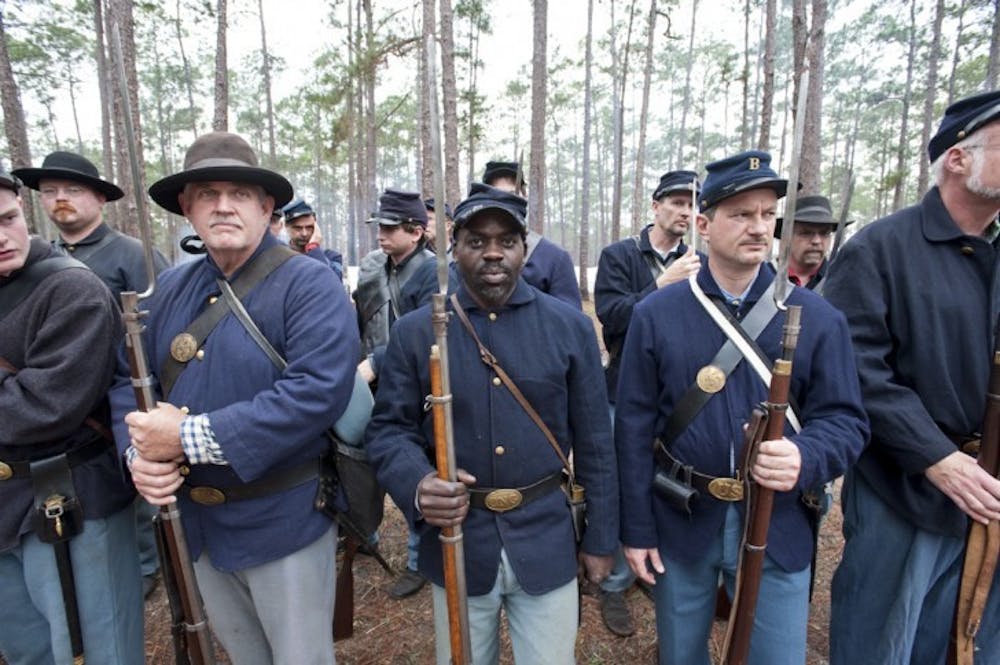General Truman A. Seymour lost the Battle of Olustee in 1864. Gen. James Permane has lost it 26 times since.
Every year since 1986, for one weekend in February, Permane leaves his job at a sports bar in Sarasota, dons the uniform of the United States Army, and leads his troops to defeat.
Permane, a 52-year-old Civil War reenactor, plays Seymour's part at the annual Olustee reenactment — Florida's largest Civil War battle.
The battle was part of an attempt by troops to restore Florida to the Union. Seymour, a Westpoint art teacher-turned-general, was unsuccessful in his efforts, though the Confederacy would surrender little more than a year after the decisive battle.
Permane, who said he reads Seymour's letters from the battlefield to get into character, studied history at UF until dropping out in the '80s. A soft-spoken man with blue eyes and red-gold curls that hang to his shoulders, he says he never gets tired of losing — it's all about the experience.
"You get a buzz being out there," he said.
He's not alone. About 600 men, women and children put on the wool uniforms of the Confederacy and the Union last weekend to face off on a battlefield about three football fields long.
Armed with muskets, bayonets, sabres and cannons, the troops recreated the meeting of 5,500 Union men and 5,200 Confederates that ended in a decisive Confederate victory, leaving 2,807 men dead or wounded.
The reenactment, now in its 36th year, is a three-day event that started Friday and lasted through Sunday afternoon at the Olustee Battlefield Historic State Park. Participants set up camp and held public demonstrations of wartime life, music and medicine, all leading up to the main event: the hour-long reenactment Sunday afternoon.
At about 12:30 p.m., about 250 men fighting for the Union fell into formation to be inspected by their units' commanding officers.
As the men went through basic drills — left face, right face, present arms — a sergeant raised the call, "The Rebels are marching!"
Under a tattered American flag bearing four big holes, the troops marched into the woods. As they neared the battlefield, lined with overflowing bleachers, the men executed what Permane describes as a "choreographed dance" where they precisely followed the original battle's progression.
Riding Jenny, a dark brown mare from Alabama, Permane sent his cavalry into battle first, charging the lines of Rebel infantrymen.
As the infantry fell back, the Union artillery fired its six cannons at once, sending smoke over the battlefield.
Jenny never faltered.
Strong gusts of wind blew sand, smoke and gunpowder into the men's eyes, and Permane sent the infantry marching out to meet the Confederate Army in the center of the field.
Permane and Jenny cantered out to the right flank, shouting encouragement and direction to the units including the Third Battalion, under the command of 1st Lt. Jeff Grzelak.
Under heavy fire, the right flank fell back. As it did, Edgar McCray, a 40-year-old urban tree remover from Orlando, was shot and killed.
McCray is in his second year of Civil War reenactments. It was his love of history that drew him in.
His commanding officer, Grzelak, made it out of the battle alive but said he's died many times in his 36 years of reenactments.
Soldiers on the field range from 16-year-old boys to men in their 70s. Though it doesn't happen often, Grzelak said he has seen some men actually die in battle, mostly from heat exhaustion.
"That's the way I wanna go," he said, "on the battlefield."
As Grzelak and his unit retreated to the treeline, Permane steered Jenny around to the other side of the field as the left flank fell.
Permane and his officers shot deserters as they tried to flee the battle, and the outlook grew dimmer.
Confederate reinforcements rode out onto the field, bringing artillery and waving the flag of the Confederate State of Florida. Whooping and hollering, the rebels pressed harder, pushing the Union troops back.
Finally, after watching man after man fall to the ground, Permane took off his wide-brimmed hat and waved it, leading his troops off the field.
The Confederate Army chased after them, firing at their backs and taking captives.
As the Confederate victory was assured, men helped each other up off the ground, brushing grass and sand off each others' uniforms.
The Confederate bugles played "Taps" as men crossed the field, rejoining their units to march back to camp and pack up their tents.
Permane dismounted and walked alone to the Union headquarters where his tent, the largest in camp, snapped in the breeze.
The formalities of battle over, he was no longer a general of the Union Army, just a guy from Sarasota who has a cellphone and eats cheeseburgers.
As tractors towed cannons away from the battlefield and men loaded their muskets into the beds of red Ford F-150s, Permane packed up his belongings.
Weekend generals have to take down their own tents.
Edgar McCray, of the 54th Regiment Massachusetts Volunteer Infantry, stands in formation during an afternoon inspection Saturday.






